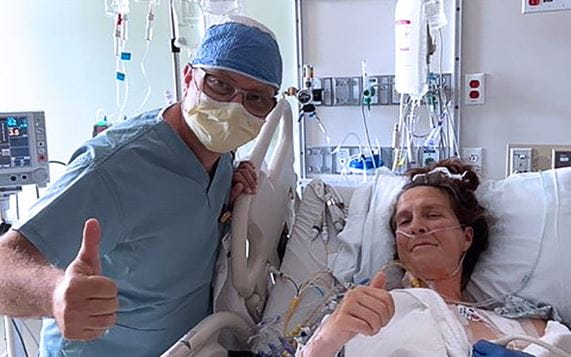Patient With Advanced Heart Disease Finds New Hope From Heart Transplant
September 09, 2020

For decades, patients facing the uncertainty of advanced heart failure have found assurance from University Hospitals Transplant Institute. UH offers a highly qualified multidisciplinary transplant team of experts backed by valuable experience and solid research. In recent years, UH has invested heavily in its advanced heart failure team, increasing the number of heart transplants and saving the lives of more patients.
This is a time of strengthening for the UH Transplant Institute as a whole. In 2019, UH completed 195 organ transplants, the largest volume in the hospital’s history. By July 2020, the team completed 182 organ transplants, on track to more than double numbers from last year. UH transplanted 18 hearts total in 2019, but hit that number by July 2020.
“This progressive growth is thanks to the highly talented and diverse group of cardiologists, surgeons, nurses, advanced practice providers, dietitians and social workers, who all work together tirelessly to care for patients,” says Eiran Gorodeski, MD, Section Chief of Advanced Heart Failure at UH Cleveland Medical Center. “We strive to be the home for advanced heart failure for patients who choose to receive care at UH.”
Each Number Has a Name
While increasing numbers are impressive, our doctors know each of these numbers personally. These numbers have names and in 2020, number 18 is Lynn Ulatowski.
In December 2014, at the age 45, Lynn was diagnosed with arrhythmogenic right ventricular cardiomyopathy (ARVC), a progressive heart disease. Lynn’s mother died from heart disease in her 40s when Lynn was just a teenager. Lynn didn’t want to relive the same fate and leave her own teenage daughter without a mother.
At that time, her doctors at another hospital system implanted her with an internal defibrillator. But this spring, she quickly declined. She felt faint more often and once needed to be shocked by her defibrillator. Her doctors suggested she seek care at UH, but by the time she was admitted on July 3, her condition was so dire she was placed on ECMO (the "heart-lung machine") and put at the top of the list for transplant. Within hours Lynn received an offer, although doctors ultimately decided that heart wasn’t a viable option. But just two days after being listed, on July 5, she received another offer and underwent a successful heart transplant.
“This is an incredible achievement for any center, but touches on the wide array of resources that are available at UH,” says Marc Pelletier, MD, Chief of Cardiothoracic Surgery at UH Cleveland Medical Center. “This includes the human resources of many healthcare workers and doctors who joined on a phone call on a holiday afternoon to review her case and agree that she should be listed for transplant.”
“It was absolutely an incredible experience,” Lynn says. “There's not one person I can say anything negative about from the person who cleaned my room, to the doctor who did the transplant. Everyone in between was just amazing.”
Lynn has a doctorate in nutrition and teaches at Ursuline College in the biology department. While recovering, she even taught a virtual class from her hospital bed. Within a month of her transplant, she was doing a little more each day -- cooking, baking and walking her dog.
"Somebody gave their life for me, I’m not going to let that go to waste," she says.
Reanimating Hearts
Routinely, a donor heart comes from someone who is considered brain dead. The donor heart is still beating inside the body until the moment of retrieval and is transported to the recipient in cold storage.
The DCD technique uses hearts that have stopped beating and reanimates them outside the donor’s body to begin beating once again. This is usually done by placing the heart on the Organ Care System, a transportable machine that pumps blood through the heart. The organ remains on the system, beating, until it gets to the recipient. When it’s time, the heart is implanted through a standard heart transplant procedure.


